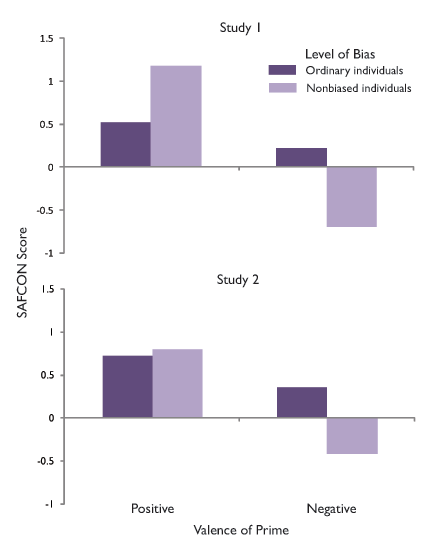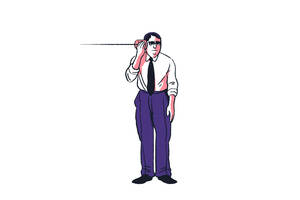Leadership Policy Oct 1, 2008
Stacking the Deck Against Racism
A psychological explanation for impartiality
America prefers to envision itself as a land of equality, where people coexist in a melting pot or a rainbow of colors and cultures. As a society, we value freedom and fairness for all, and we work to fight prejudice and discrimination in our government, our neighborhoods, and wherever else it may hide. While many people claim to be free from racial bias, recent research from Robert W. Livingston, Kellogg School of Management, and Brian B. Drwecki, University of Wisconsin-Madison, suggests that people are not always aware of the subconscious attitudes that govern them. How can prejudice persist despite people’s values and motivations to the contrary? According to Livingston, the answer lies in differential susceptibility to affective conditioning.
Affective conditioning is a form of associative learning that Livingston describes as “the micro-level psychological mechanisms that affect the way one processes information in the world.” The way people associate affects or emotions with different stimuli in the environment contributes to attitude formation. Livingston examines whether mechanisms underlying the formation of affect associations also govern the formation of racial bias. He concludes that, indeed, individuals who are susceptible to developing negative affective or emotional associations are more prone to developing racial bias.
Studying Nonbiased Individuals to Understand Avoiding Bias
Historically, many studies in social psychology have focused primarily on racially-biased individuals to reveal the social, historical, and economic determinants of racial prejudice. However, this approach neglects to consider the value in examining those who are not racially biased. Adopting a positive psychology approach, Livingston and Drwecki examine the etiology of prejudice in nonbiased individuals. Positive psychology was created by Martin E. P. Seligman and others at the University of Pennsylvania in order to study the strengths and virtues that enable individuals and communities to thrive. Livingston argues that by examining nonbiased individuals, the researchers could “understand the cognitive processes that enable them to avoid racial bias at all levels.”
Sociologists and psychologists have long puzzled over the persistence of racial prejudice in a society that so explicitly condemns such practices.To better understand these cognitive processes, the authors set up two studies under a classical conditioning paradigm. The first study included eighteen white undergraduate students who demonstrated extremely low or null levels of bias in both the Implicit Association Test (IAT) and the Attitudes Toward Blacks scale measuring implicit and explicit bias respectively. In addition, ninety-two ordinary unscreened white students were recruited for the study. Both groups completed three tests. Initially, they participated in a task assessing susceptibility to affective conditioning (SAFCON). The authors created the task to gauge the propensity with which individuals acquire positive and negative affective associations to neutral stimuli.1 The second test measured category-based processing in a “who-said-what” task.2 This test enabled the authors to test whether people who tend to categorize (i.e., to perceive individuals as “in-group” and “out-group”) are also prone to racial bias. Finally, inhibitory ability—the ability to suppress racial bias—was measured by a color-naming Stroop task. 3
Impact of Positive and Negative Early Childhood Socialization
The results demonstrate that individual differences in affective orientation predict racial attitudes. Nonbiased individuals have a general affective orientation that predisposes them to be less susceptible to acquire negative affect and more susceptible to acquire positive affect than ordinary individuals (see Figure 1). According to Livingston, the researchers are still determining what causes people to differ, but he speculates that factors such as early childhood socialization may have a significant role. “People develop different affect orientation in response to their environment,” he said. “If you live in an environment with lots of threat, you will be more prone to negativity because it is going to be more beneficial for you for survival purposes; whereas if you are raised in a warmer, nurturer environment, because of the relative absence of threat in your environment, you might be more prone to focus on positivity.”
In the second and third tests, the ability to suppress racial bias did not predict racial nonbias, but categorization did. It is widely believed that those who tend to categorize people by race also tend to be more prejudiced. Livingston explored this connection in previous papers. But in this paper, the authors found that categorization has an independent significant effect on racial bias against African Americans, demonstrating that susceptibility to affective conditioning and categorization are two different processes. Livingston speculates that “there are certain people that are more likely to attach positive and negative affects to things in the world and there are certain people who like to categorize individuals by race; and if you put these two together … people who tend to categorize first notice that somebody is from a different race, and because of their differential conditioning they are more likely to attach negative aspects to that category that is more salient to them.”
Because the results of the first study might have depended on the type of stimuli presented in the tests, the authors ran a second study focusing exclusively on SAFCON. Categorization and inhibitory process were not measured and the SAFCON task included different primes or stimuli. Furthermore, the authors expanded the sample size of the nonbiased group and reduced the size of the unscreened group to twenty-four and seventy-seven students respectively, The nonbiased group of students were nominated by African-American students, since it is widely assumed that African Americans can accurately detect racial bias,. The second study demonstrated that although the two groups were equally susceptible to positive conditioning, ordinary subjects were more susceptible to negative conditioning than nonbiased subjects. Figure 1 shows the results of both studies.

These studies show that susceptibility to affective conditioning (SAFCON) predicts non-prejudice toward African Americans, but Livingston cautions against applying the idea to other minority groups. “We did a study where we gave people the IAT for Black, Latino, and Asian individuals and we measured the prejudice in those groups, and it turns out that SAFCON only predicts non-prejudice toward blacks.” Livingston attributes this to the particular composition and history of American society. “If this is based on conditioning of people’s susceptibility to affective conditioning, it makes sense that we have the most negative attitudes toward the group that has the most negative conditioning in this society,” he argues. He also ran studies measuring gender and weight bias, but SAFCON did not predict those prejudices. Currently, Livingston is conducting more studies to test his results with different social and social-class groups.
Sociologists and psychologists have long puzzled over the persistence of racial prejudice in a society that so explicitly condemns such practices and this study offers important insights into the mystery. Livingston’s results indicate that education, values, and professed beliefs only go so far in predicting underlying attitudes—micro-level psychological processes that affect the way one processes information in the world can subconsciously undermine good intentions. Thus, idealism alone is not enough to reduce racial prejudice. As Livingston explains, “Imagine you do not like the taste of spinach, but research comes out and says it is so nutritious that it will prevent you from getting cancer or any disease. So at that point you are motivated to eat spinach, but it is not that simple to change the reaction to spinach when you put it in your mouth. In some ways, racial attitudes are similar; even though people are highly motivated to get rid of the negativity they have, they can’t. It is not a matter of sheer force or will that overrides these basic affects or processes that are creating people’s negativity towards race.” He explains that the way to reverse these mechanisms is through reconditioning: racial contact through close friendships and repetitive exposure to racial diversity can induce a positive conditioning and counteract the negativity.
A greater understanding of susceptibility to affective conditioning transcends the question of racial prejudice and has broad implications for optimizing job performance and success in the business environment. It can explain less tangible qualities such as what inspires some people to persist in the face of negativity when others give up, or why people respond differently to negative comments, criticisms, or negative outcomes. As Livingston observes, “Affect process is a general hardwire complex that orients us to the world in general, and to how we are going to respond to positive versus negative events overall.”
Notes
1 For the SAFCON task, positive and negative images from the International Affective Picture System were selected as well as nine Chinese ideographs. Each Chinese ideograph was paired with one positive, one negative, and one neutral prime across three sets. Participants were randomly assigned to one of the three sets and after seeing the images, they rated their liking of the Chinese ideographs.
2 For measuring category-based processing, participants completed a “who-said-what” task in which they viewed a simulated conversation between three white men and three black men. They were then presented with twelve statements and participants had to match a photo with the phrase.
3 For measuring inhibitory ability participants were presented with color-congruent words (e.g., the word “green” presented in a green hue) and color-incongruent words (e.g., the word “red” presented in a green hue). Inhibitory ability was measured by subtracting reaction time on congruent trials from reaction time on incongruent trials.
Livingston, R. W. and Brian B. Drwecki (2007), “Why are some individuals not racially biased? Susceptibility to affective conditioning predicts nonprejudice toward blacks.” Psychological Science, September, 18(9): 816-823.


